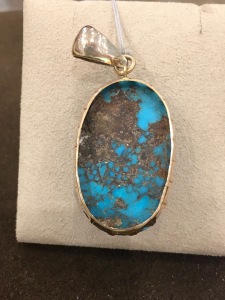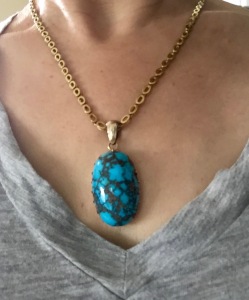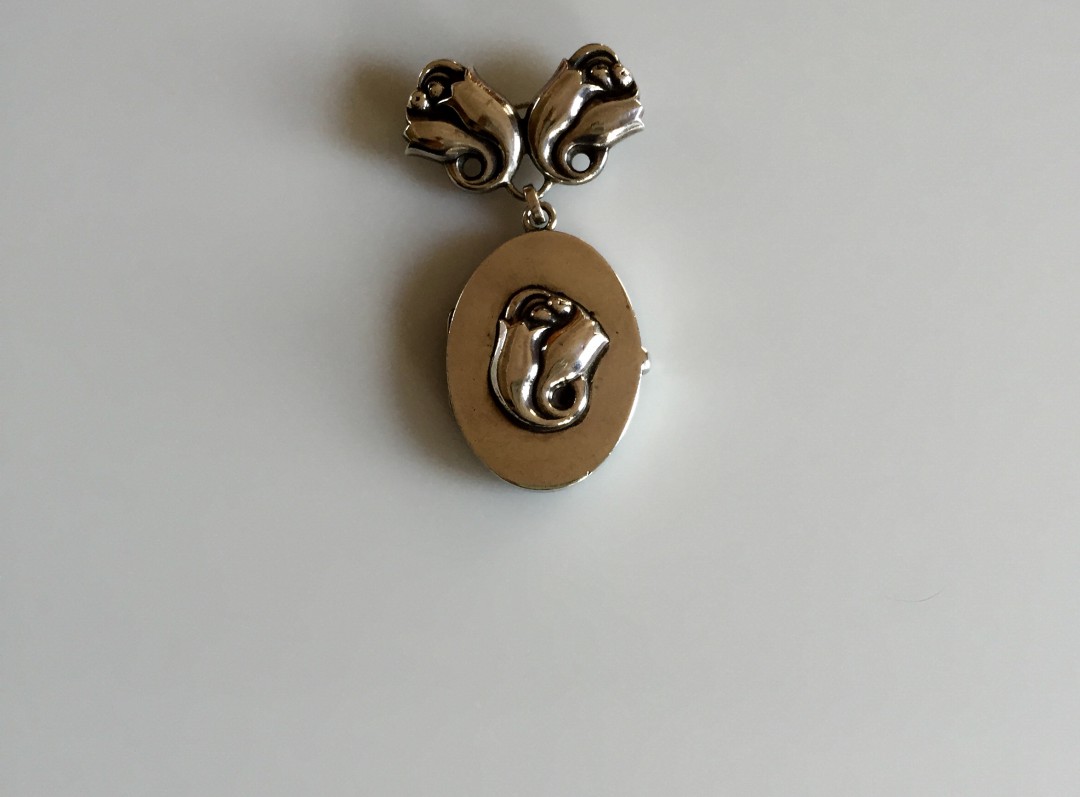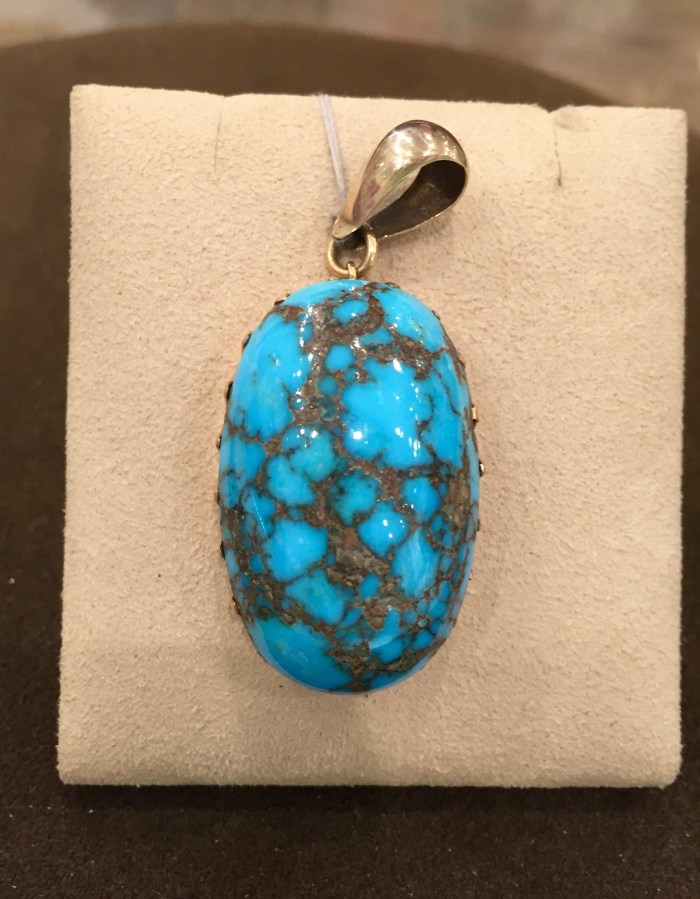Last summer, you may recall, I was congratulating myself on my ability to resist a certain turquoise pendant. It was huge, an eye-popper. The color just about knocked me over. But resist I did, because it was quite expensive, and because it seemed to exist in its own universe. It wasn’t a piece of jewelry; it was an event.
The pendant was an estate piece from the collection of Matt Miranda, a jeweler who knows his turquoise. I saw it in a case in my favorite store in Santa Fe, True West Gallery, and kept coming back to it. Its setting was minimal: a sawtooth bezel that hung off the back of the stone like hip hop pants on a rap artist. But the color cried out. What kind of turquoise was it?

That, dear reader, is a guessing game. Unless there’s a record of where a specific stone was mined, even an expert can’t know for sure, and this stone was mined a long time ago. Its ‘water web’ pattern—intense color that seems to float above the matrix—looks like Bisbee turquoise, from an Arizona mine that closed in the 70s. But several experts who examined this stone thought it could just as easily be high-grade Persian turquoise from Iran. (High-grade turquoise is the hardest and takes the best polish.) All we know for sure is that it’s good.
As I said, I didn’t buy it. I wasn’t convinced I could wear it. But I thought about it. So this past summer, though I didn’t visit Santa Fe, I messaged the gallery owner and asked if the price might come down. It did, just enough to make me say what the hell and write a check. I felt a bit vexed with myself, because I’ve gotten really good at resisting jewelry—I’ve basically stopped buying it. But the damn thing was calling me.
Around this time, my jeweler friend Nan Irwin texted me a photo of a gold chain she found in the scrap pile at the smelter. Someone had exchanged it for cash, but it hadn’t been melted down yet. It was an unusual chain, oversized and clearly handmade, and I agreed with Nan that it would be a shame to melt it. Perhaps it would work with the similarly oversized turquoise?

 I bought the chain, which turned out to be 18 karat gold. (Sold by the gram. Many grams.) It was indeed the right scale for the turquoise pendant, but it was too long. In the photo at left, I hiked it up to what I thought would be its proper length, but even so, the pendant hung there like an albatross. The stone was too long, too wide, too deep. With the bezel affixed to the back like an afterthought, it wasn’t properly balanced. I knew it needed a new, more protective setting, which wouldn’t be cheap. I also knew this project would be more complicated than it looked. Every project is, if you do it right.
I bought the chain, which turned out to be 18 karat gold. (Sold by the gram. Many grams.) It was indeed the right scale for the turquoise pendant, but it was too long. In the photo at left, I hiked it up to what I thought would be its proper length, but even so, the pendant hung there like an albatross. The stone was too long, too wide, too deep. With the bezel affixed to the back like an afterthought, it wasn’t properly balanced. I knew it needed a new, more protective setting, which wouldn’t be cheap. I also knew this project would be more complicated than it looked. Every project is, if you do it right.
I handed it over to Nan. I was going to be traveling and knew I could trust her to sweat the details. There was one very significant detail: a small gouge in the stone. (You can see it in the photo above that shows the side view.) This meant that the usual way of hand-making a bezel setting—pushing a thin sheet of gold against the stone—wouldn’t work. It might look funky, or, worse, break the stone.

The solution: a setting where the stone would sit on a sturdy platform so the bezel could safely be folded around it. This was designed on a computer, above. First the stone was scanned to reveal its exact dimensions, gouge and all. A design was created, tweaked, retweaked. Then a 3D printer spit out a model, below left, which was cast in 20 karat gold, below right. (I’m simplifying this. More than one kind of setting was considered, and more than one model was created.)
Those stems at the back of the rough gold are sprues—channels the gold flowed through when the piece was cast. The turquoise did not fit into this casting; gold had to be shaved away to make room for it, and the bezel had to be thinned and shaped. That’s how these things are done. CAD designer, caster, finisher: multiple artisans worked on this piece.
I saw none of these steps. I knew the setting would be as simple as Nan could make it, and I kind of wanted to be surprised. (Unusual for me.) The result was a pendant that’s heftier than the original, larger by about three millimeters all the way round. And yet, while the original was too big for me to wear, the new version is not. It no longer looks like a rock on a chain. The proportions are right.

The chain, at 20 inches, is still too long. But I don’t plan to shorten it much—maybe an inch. It’s going to be a big, dramatic piece, and I’ll have to figure out what to wear it with—a long black sweater, maybe. I may not wear it often; you’d be surprised how little jewelry I wear most of the time. But I felt compelled to give this extraordinary stone a proper home. And now I’ve done right by it.







Wonderful results!
LikeLike
Marcia
What a wonderful write up about the journey of this amazing turquoise stone. We are just the caretakers of pieces like this and hopefully when they leave our possession a new person sees the beauty and becomes the next caretaker. I can only imagine the delight and awe of the previous owner.
The final product looks perfect! I am so happy to see such a fine example of Turquoise calling you and to be so lovingly executed. 👍🏻
LikeLike
Enjoyed reading the saga of the turquoise. It looks perfect ensconced in new setting with it’s handcrafted chain. Did good!
Sent from my Sprint Samsung Galaxy S® 6.
LikeLike
beautiful…Fran did an exceptional job !
LikeLike
It is VERY lovely.
LikeLike
I have worked with Persian neyshaburi turquoise all my life (50 now) from the area, and can say without a doubt this is neyshaburi and from the abu razak pit, this easy runs in the tens of thousands now on the market in my country. Congratulations
LikeLike
Sorry forget to add the key to knowing that it is not morenci or American turquoise is the subtilties in color, but most importantly we Persians cut high dome and still do, but have switched to 50-50 for slice cut since good pits like the one yours is from have run out, there is a new pit they recently found with similar material that cost s an arm and an leg, these material tend be found in flooded pits ie deeper pits of the mine. The mine overall has been extensively mined prior to written history, but there is potentially new turquoise areas nearby, that could rejuvinate the market with new examples such as yours.
LikeLiked by 1 person
Thanks so much for your comments! I’m thrilled to have solved the mystery of the stone. The dealer who sold it to me will be happy to know where it came from, and why it’s so exceptionally beautiful.
LikeLike
What a lovely Persian turquoise stone! Please let me know if you want to sell it.
LikeLike
I appreciate your interest! It’s staying with me for now, but I will keep you in mind.
LikeLike